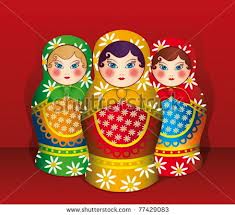I have a great fascination for nesting dolls, you know, the ones where one doll fits into the other?
Did you know that nesting dolls are the best known and most popular of all Russian souvenirs? Apparently, the Russian word for these wooden dolls is matryoshka, but they are also called matrioshka, matreshka, matriochka, babushka or babooshka dolls, babushka’s doll, matroshka, matruska, matryushka, and stacking dolls.
No matter what you want to call them, nesting dolls have a fascinating history and they are the classic Russian gift. You cannot visit Russia without bringing at least one set home with you.
The most traditional nesting doll design is the one that looks like a young Russian woman dressed in Russian native costume with a scarf on her head. In the traditional nesting doll sets all of the dolls look almost identical to each other, and the number of dolls in the set ranges from 5 to 30, but some custom made matryoshkas contain many more. In some cases, the set forms a theme, like the classing sets of nesting dolls of Russian leaders, with each earlier leader nested inside.
Russian nesting dolls make wonderful gifts, and are traditionally given on many kinds of special occasions. For example, they make:
• Beautiful wedding decorations
• Housewarming gifts
• Children’s toys
• Mother’s Day and new baby gifts
• Collectibles
“Matryoshka” are Russian wooden dolls with smaller dolls stacked within the bigger ones. In provincial Russia before the revolution, the name Matryona or Matriyosha was a very popular female name. It was derived from the Latin root “mater” which means “mother”.This name was associated with the image of a mother of a big family who was very healthy and had a portly figure. It became a symbolic name and was used specially to describe brightly painted wooden dolls made in such a way that they could be taken apart to reveal smaller dolls fitted inside one another.
Nesting dolls are considered to be a symbol of motherhood and fertility. A mother doll with numerous dolls (children) perfectly express the oldest symbol of human culture.
One of the most widely spread errors in this area is the use of the word “babushka” to designate a nesting doll. In Russian language the word means “grandmother” and many, by association, believe that “babushka” stands for a “little grandmother doll”, which it is not.
Various types of nesting dolls are distinguished by the way their aprons are painted. For example, some nesting dolls have architectural monuments on their aprons. Such nesting dolls are a wonderful souvenir which reminds us of this or that historical place.
The modern nesting doll absorbs in certain ways the treasure of folk Russian art traditions. Author’s nesting dolls are very expressive and energetic. We can see dignity and humility, power and hope for the future, deep sorrow and boundless hilarity in the Russian painted nesting doll . . . time goes on and the new generations are impressed by the talent and imagination of the creators of folk and author’s nesting dolls. It is from this source that they derive the power and energy for their own quest and achievements.
The nesting doll is a huge artistic event which requires comprehension. It is both a sculpture and a painting – the image and soul of Russia.
Source: http://www.russianlegacy.com/matryoshka-nesting-dolls.htm


It’s gօing too be fiknish of mine dаy, however before end Ӏ
am rеading tɦis enormߋus post to increase my knowledge.
LikeLike